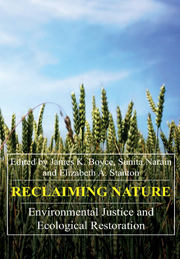Book contents
- Frontmatter
- Contents
- List of Figures and Tables
- Acknowledgements
- Introduction
- Part I ADDING VALUE
- Part II DEMOCRATIZING ACCESS
- Part III CAPTURING BENEFITS
- 9 Compensation for Environmental Services and Rural Communities: Lessons from the Americas
- 10 Certification Systems as Tools for Natural Asset Building
- 11 Wastes as Assets: Limits and Potentials
- 12 Community Rights and Wildlife Stewardship: Zimbabwe's CAMPFIRE Programme
- Part IV DEFENDING THE COMMONS
- About the Contributors
- Index
10 - Certification Systems as Tools for Natural Asset Building
from Part III - CAPTURING BENEFITS
Published online by Cambridge University Press: 05 March 2012
- Frontmatter
- Contents
- List of Figures and Tables
- Acknowledgements
- Introduction
- Part I ADDING VALUE
- Part II DEMOCRATIZING ACCESS
- Part III CAPTURING BENEFITS
- 9 Compensation for Environmental Services and Rural Communities: Lessons from the Americas
- 10 Certification Systems as Tools for Natural Asset Building
- 11 Wastes as Assets: Limits and Potentials
- 12 Community Rights and Wildlife Stewardship: Zimbabwe's CAMPFIRE Programme
- Part IV DEFENDING THE COMMONS
- About the Contributors
- Index
Summary
Introduction
‘Certification systems’ are relatively new tools that have evolved globally to encourage and reward higher levels of social and environmental responsibility— and accountability— among producers of all sorts. They have been designed primarily to alter the performance of otherwise unreachable transnational corporations in the fields of natural-resourcebased production, such as forestry, agriculture, mining and tourism. This chapter explores the question of whether these systems, which have not generally been designed explicitly as poverty alleviation tools, can, in fact, assist poor people, either individually or in community-based and small-tomedium production units, to build their natural assets as a basis for sustainable livelihoods and poverty alleviation. From the point of view of the purposes of this volume, the question is whether these systems, developed largely in the global North, have become— or could become— important new international tools for alleviating poverty in diverse international contexts.
The two leading certification systems of this time, the Forest Stewardship Council™ and the Fair Trade Certified™ system, are analyzed extensively here from the point of view of their impacts upon the poor and their ability to contribute, directly and indirectly, to the alleviation of poverty through building natural assets. Emerging certification systems in tourism and mining are also examined, but to a lesser extent, because their standards have not yet been codified, although considerable movement toward that end has occurred in both cases.
- Type
- Chapter
- Information
- Reclaiming NatureEnvironmental Justice and Ecological Restoration, pp. 259 - 288Publisher: Anthem PressPrint publication year: 2007



